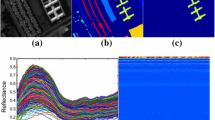Abstract
With the increasing interest in the deployment of wireless multimedia sensor networks (WMSN), new challenges have arisen with the complexity and high noise level of the monitoring environment. Given that the noise severely impairs the quality and visibility of video images perceived by sensors, video image denoising naturally becomes the key to ensure the validity and reliability of the WMSN video monitoring. In this paper, the sparse denoising algorithm via clustering-based sparse representation is proposed. Firstly, WMSN images are, respectively, clustered based on the pixel intensity of regions of interest (ROIs), which are determined in terms of Bayesian theorem. Secondly, in the light of nonlocal self-similarity regularizer provided by the ROI-based WMSN images clustering, clustering-based sparse representation builds a new sparse denoising model exploiting both sparsity and nonlocal self-similarity to improve the quality of reconstructed images. At last, a surrogate-function-based iterative shrinkage solution has been developed to solve the double-header \(l_{1}\)-optimization problem. Experimental results showed that the performance of the approach to image denoising is competitive, qualitative, as well as quantitative, and suitable for the WMSN video image denoising.





Similar content being viewed by others
References
I.F. Akyildiz, T. Melodia, K.R. Chowdhury, A survey on wireless multimedia sensor networks. Comput. Netw. 51(4), 921–960 (2007)
I.F. Akyildiz, T. Melodia, K.R. Chowdhury, Wireless multimedia sensor networks: applications and testbeds. Proc. IEEE. 96(10), 1588–1605 (2008)
P. Barnum, S. Narasimhan, T. Kanade, Analysis of rain and snow in frequency space. Int. J. Comput. Vis. 86(23), 256–274 (2010)
M.C. Chi, C.H. Yeh, M.J. Chen, C.T. Hsu, Robust region-of-interest determination based on user attention model through visual rhythm analysis. IEEE Trans. Circuits Syst. Video Technol. 19(7), 1025–1038 (2009)
P. Chatterjee, P. Milanfar, Clustering-based denoising with locally learned dictionaries. IEEE Trans. Image Process. 18(7), 1438–1451 (2009)
K. Dabov, A. Foi, V. Katkovnik, K. Egiazarian, Image denoising by sparse 3-D transform-domain collaborative filtering. IEEE Trans. Image Process. 16(8), 2080–2095 (2007)
R. Dai, I.F. Akyildiz, A spatial correlation model for visual information in wireless multimedia sensor networks. IEEE Trans. Multimed. 11(6), 1148–1159 (2009)
W. Dong, X. Li, L. Zhang, G. Shi, Sparsity-based image denoising via dictionary learning and structural clustering, in IEEE Conference on Computer Vision and Pattern Recognition (2011), pp. 457–464
M. Elad, M. Aharon, Image denoising via sparse and redundant representations over learned dictionaries. IEEE Trans. Image Process. 15(12), 3736–3745 (2006)
M.J. Fadili, J.L. Starck, J. Bobin, Y. Moudden, Image decomposition and separation using sparse representations: an overview. Proc. IEEE. 98(6), 983–994 (2010)
S. Feizi, D. Marbach, M. Medard, M. Kellis, Network deconvolution as a general method to distinguish direct dependencies in networks. Nat. Biotechnol. 31(8), 726–733 (2013)
X. Gu, G. Qiu, X. Feng, D. Liu, Z. Chen, Region of interest weighted pooling strategy for video quality metric. Telecommun. Syst. 49(1), 63–73 (2011)
Y. Guo, A. Sengur, A novel color image segmentation approach based on neutrosophic set and modified fuzzy c-means. Circuits Syst. Signal Process. 32, 1699–1723 (2013)
E.T. Hale, W. Yin, Y. Zhang, A fixed-point continuation method for\(l_1 \)-regularized minimization with applications to compressed sensing. Technical Report, CAAM TR07-07 (2007).
S. Huang, M. Chen, K. Tai, M. Li, Region-of-interest determination and bit-rate conversion for H.264 video transcoding. EURASIP J. Adv. Signal Process. 1, 112–125 (2013)
J. Portilla, V. Strela, M.J. Wainwright, E.P. Simoncelli, Image denoising using scale mixtures of Gaussians in the wavelet domain. IEEE Trans. Image Process. 12(11), 1338–1351 (2003)
K. Skretting, K. Engan, Recursive least squares dictionary learning algorithm. IEEE Trans. Signal Process. 58, 2121–2130 (2010)
S. Valiollahzadeh, H. Firouzi, M. Babaie-Zadeh, C. Jutten, Image denoising using sparse representations, in Proceedings of the International Conference on Independent Component Analysis and Signal Separation (2009), pp. 557–564.
B. Wang, Z. Tu, Sparse subspace denoising for image manifolds, in IEEE Conference on Computer Vision and Pattern Recognition (2013), pp. 468–475.
B. Wang, A.M. Mezlini, F. Demir, M. Fiume, Z.W. Tu, M. Brudno, B. Haibe-Kains, A. Goldenberg, Similarity network fusion for aggregating data types on a genomic scale. Nat. Methods 11(3), 333–337 (2014)
S. Yang, L. Zhao, M. Wang, Y. Zhao, L. Jiao, Dictionary learning and similarity regularization based image noise reduction. J. Vis. Commun. Image R. 24(2), 181–186 (2013)
Acknowledgments
This work is supported by the National Natural Science Foundation “Research on Video Image Processing Method Based on Compressed Sensing for Railway Foreign Invasion Monitoring in the Mountainous” (No. 61261040).
Author information
Authors and Affiliations
Corresponding author
Rights and permissions
About this article
Cite this article
Luo, H., Chu, H. & Xu, Y. Clustering-Based Image Sparse Denoising in Wireless Multimedia Sensor Networks. Circuits Syst Signal Process 34, 1027–1040 (2015). https://doi.org/10.1007/s00034-014-9882-6
Received:
Revised:
Accepted:
Published:
Issue Date:
DOI: https://doi.org/10.1007/s00034-014-9882-6




